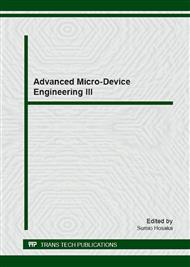[1]
B. Arkles: Chemtech Vol. 7 (1977), p.766.
Google Scholar
[2]
S. Naviroj, J.L. Koenig and H. Ishida: J. Adhes. Vol. 18 (1985), p.93.
Google Scholar
[3]
E.P. Plueddemann: Silane Coupling Agents, 1st and 2nd ed., Plenum Press, New York (1982 and 1991).
Google Scholar
[4]
K. Kakiage, T. Kyomen, M. Unno and M. Hanaya: Silicon Vol. 1 (2009), p.191.
Google Scholar
[5]
K. Kakiage, M. Yamamura, E. Ido, T. Kyomen, M. Unno and M. Hanaya: Appl. Organometal. Chem. Vol. 25 (2011), p.98.
DOI: 10.1002/aoc.1722
Google Scholar
[6]
The Chemistry of Organic Silicon Compounds Volume 1-3, edited by S. Patai, Z. Rappoport and Y. Apeloig, John Wiley & Sons, Chichester (1989-2001).
Google Scholar
[7]
Organosilicon Chemistry I-VI: From Molecules to Materials, edited by N. Auner and J. Weis, Wiley-VCH, Weinheim (1993-2005).
Google Scholar
[8]
Silanes and other Coupling Agents Volume 1-5, edited by K.L. Mittal, VSP, Utrecht (1992-2009).
Google Scholar
[9]
K. Kakiage, Y. Nakada, T. Kogure, M. Yamamura, T. Kyomen, M. Unno and M. Hanaya: Silicon Chem. Vol. 3 (2008), p.303.
DOI: 10.1007/s11201-008-9032-8
Google Scholar
[10]
K. Kakiage, T. Kyomen, M. Unno and M. Hanaya: Appl. Organometal. Chem. Vol. 24 (2010), p.198.
Google Scholar
[11]
M. Unno, K. Kakiage, M. Yamamura, T. Kogure, T. Kyomen and M. Hanaya: Appl. Organometal. Chem. Vol. 24 (2010), p.247.
DOI: 10.1002/aoc.1612
Google Scholar
[12]
K. Kakiage, M. Yamamura, E. Fujimura, T. Kyomen, M. Unno and M. Hanaya: Chem. Lett. Vol. 39 (2010), p.260.
Google Scholar
[13]
K. Kakiage and M. Hanaya: Photochemistry Vol. 41 (2010), p.133.
Google Scholar
[14]
K. Kakiage, M. Yamamura, T. Kyomen, M. Unno and M. Hanaya: Key Eng. Mater. Vol. 497 (2012), p.61.
Google Scholar
[15]
T. Shimada, K. Aoki, Y. Shinoda, T. Nakamura, N. Tokunaga, S. Inagaki and T. Hayashi: J. Am. Chem. Soc. Vol. 125 (2003), p.4688.
Google Scholar
[16]
K. Aoki, T. Shimada and T. Hayashi: Tetrahedron: Asymmetry Vol. 15 (2004), p.1771.
Google Scholar
[17]
N. Fukaya, S. Onozawa, M. Ueda, K. Saitou, Y. Takagi, T. Sakakura and H. Yasuda: Chem. Lett. Vol. 39 (2010), p.402.
DOI: 10.1246/cl.2010.402
Google Scholar
[18]
N. Fukaya, S. Onozawa, M. Ueda, T. Miyaji, Y. Takagi, T. Sakakura and H. Yasuda: Chem. Lett. Vol. 40 (2011), p.212.
DOI: 10.1246/cl.2011.212
Google Scholar
[19]
N. Fukaya, M. Ueda, S. Onozawa, K. K. Bando, T. Miyaji, Y. Takagi, T. Sakakura and H. Yasuda: J. Mol. Catal. A: Chem. Vol. 342-343 (2011), p.58.
Google Scholar
[20]
T. Miyaji, S. Onozawa, N. Fukaya, M. Ueda, Y. Takagi, T. Sakakura and H. Yasuda: J. Organomet. Chem. Vol. 696 (2011), p.1565.
DOI: 10.1016/j.jorganchem.2010.12.030
Google Scholar
[21]
K. Kakiage: Development of Functional Materials by Hybridization of Metal Oxides and Organosilicon Compounds, Gunma University: Doctoral dissertation (2011).
Google Scholar
[22]
O. Jessensky, F. Müller and U. Gösele: Appl. Phys. Lett. Vol. 72 (1998), p.1173.
Google Scholar
[23]
A.P. Li, F. Müller, A. Birner, K. Nielsch and U. Gösele: J. Appl. Phys. Vol. 84 (1998), p.6023.
Google Scholar
[24]
H. Masuda, F. Matsumoto and K. Nishio: Electrochemistry Vol. 72 (2004), p.389.
Google Scholar
[25]
H. Asoh and S. Ono, Electrocrystallization in Nanotechnology, edited by G. Staikov, Wiley-VCH, Weinheim (2007), Chap. 7, pp.138-166.
Google Scholar
[26]
Y. Lei, W. Cai and G. Wilde: Prog. Mater. Sci. Vol. 52 (2007), p.465.
Google Scholar
[27]
Y.P. Wang and T.Y. Tseng: J. Mater. Sci. Vol. 34 (1999), p.4573.
Google Scholar
[28]
E. Palomares, J.N. Clifford, S.A. Haque, T. Lutz and J.R. Durrant: J. Am. Chem. Soc. Vol. 125 (2003), p.475.
Google Scholar
[29]
M. Yamamura, N. Kano, T. Kawashima, T. Matsumoto, J. Harada and K. Ogawa: J. Org. Chem. Vol. 73 (2008), p.8244.
Google Scholar
[30]
T. Weidner, F. Bretthauer, N. Ballav, H. Motschmann, H. Orendi, C. Bruhn, U. Siemeling and M. Zharnikov: Langmuir Vol. 24 (2008), p.11691.
DOI: 10.1021/la802454w
Google Scholar
[31]
B. Uno, Y. Matsuhisa, K. Kano and T. Kubota: Chem. Pharm. Bull. Vol. 32 (1984), p.1691.
Google Scholar
[32]
K. Murakoshi, G. Kano, Y. Wada, S. Yanagida, H. Miyazaki, M. Matsumoto and S. Murasawa: J. Electroanal. Chem. Vol. 396 (1995), p.27.
Google Scholar
[33]
K.S. Finnie, J.R. Bartlett and J.L. Woolfrey: Langmuir Vol. 14 (1998), p.2744.
Google Scholar
[34]
T. Kato and S. Hayase: J. Electrochem. Soc. Vol. 154 (2007), p. B117.
Google Scholar
[35]
P.D. Lickiss: Adv. Inorg. Chem. Vol. 42 (1995), p.147.
Google Scholar
[36]
I.S. Ignatyev, F. Partal and J.J.L. González: Chem. Phys. Lett. Vol. 384 (2004), p.326.
Google Scholar


